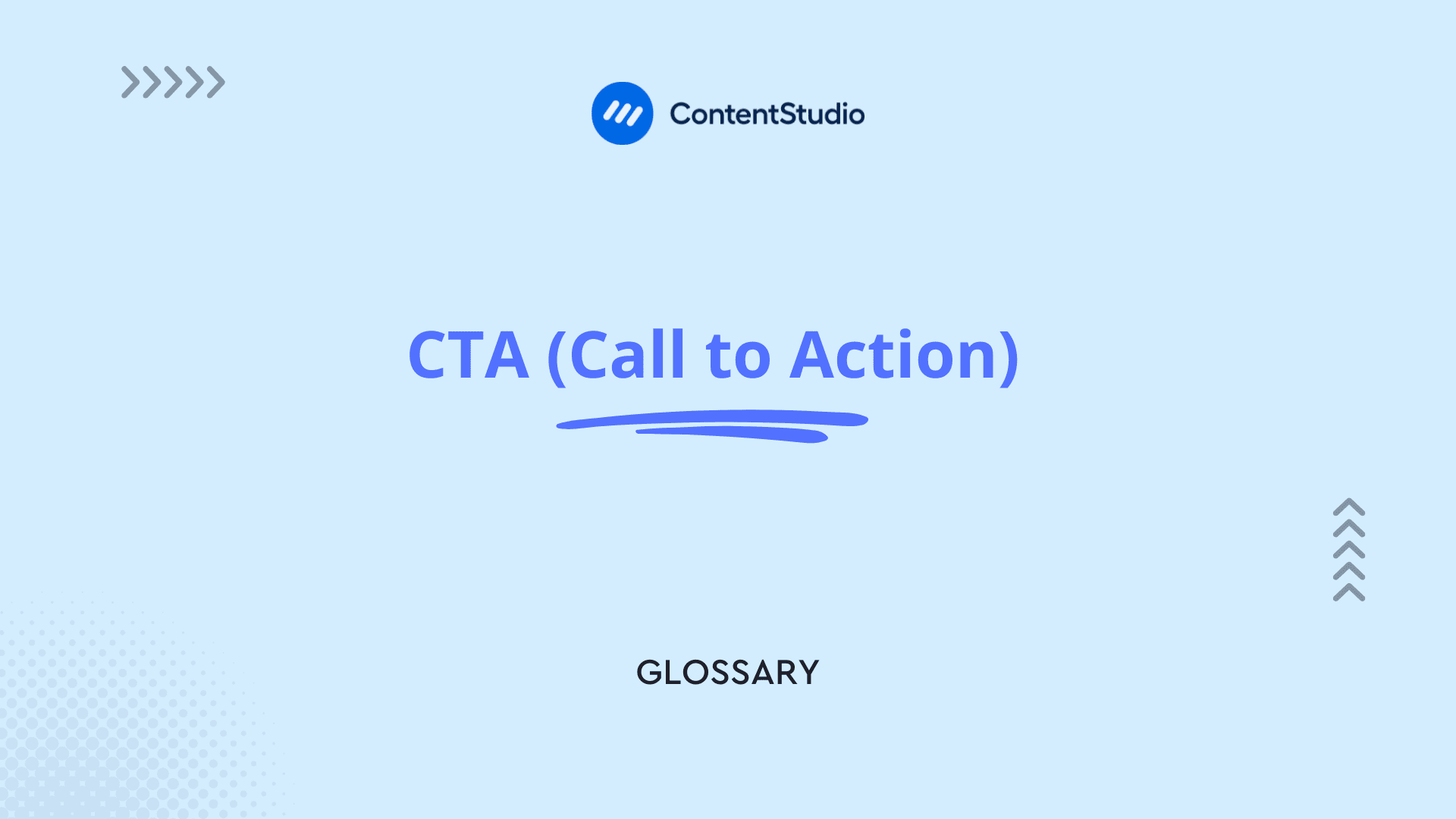Bulk-generate & schedule posts in seconds with Smart Scheduling. Try now!
CTA (Call to Action)

What is a call to action (CTA)?
A call to action, commonly known as CTA, is a marketing element that prompts your audience to take a specific desired action. It's the bridge between content consumption and conversion, guiding users toward the next step in their journey.
In social media marketing, CTAs are crucial components that transform passive readers into active participants, whether that's signing up for a newsletter, downloading a resource, or making a purchase.
Why are CTAs important in social media marketing?
In the vast landscape of social media, where content flows endlessly, CTAs serve as strategic signposts that direct user behavior. They're essential because they:
- Drive measurable results: CTAs provide clear metrics for measuring social media campaign performance, helping you track conversion rates and ROI.
- Create urgency and motivation: Well-crafted CTAs tap into psychological triggers that encourage immediate action.
- Guide the user journey: They provide clear direction on the next steps, reducing friction in the conversion process.
- Increase engagement: Strategic CTAs can boost interaction rates on your social media posts and content.
- Improve conversion rates: Clear, compelling CTAs can significantly impact your bottom line by converting more viewers into customers.
Types of CTAs in social media
Direct response CTAs
These CTAs explicitly ask users to take immediate action. They're straightforward and clear about what you want the user to do.
Common examples include:
- Shop now: Perfect for e-commerce brands promoting products
- Sign up: Ideal for newsletter subscriptions or free trial offers
- Download now: Great for offering valuable resources like ebooks or templates
- Learn more: Useful when you want to direct users to detailed information
- Get started: Effective for introducing new users to your product or service
Soft CTAs
Soft CTAs are more subtle and focus on engagement rather than immediate conversion. They're excellent for building relationships and nurturing leads through your social media marketing funnel.
Examples include:
- Share your thoughts: Encourages community engagement and discussion
- Tag a friend: Promotes organic content sharing and expansion of reach
- Save for later: Perfect for valuable content that users might want to reference
- Follow us: Build long-term connections with your audience
- Read more: Drives traffic to your detailed content pieces
Best practices for creating effective CTAs
Design elements
The visual presentation of your CTA can significantly impact its effectiveness. Consider these essential design elements:
- Contrast: Make your CTA stand out from the surrounding content using contrasting colors
- Size: Ensure your CTA is large enough to be noticed but not overwhelming
- White space: Provide adequate breathing room around your CTA
- Mobile optimization: Design CTAs that are easily clickable on mobile devices
- Visual hierarchy: Position your CTA where it naturally draws attention
Copywriting tips
The words you choose for your CTA can make or break its success. Here are key considerations for writing compelling CTAs:
- Use action verbs: Begin with strong commands like "Get," "Start," "Join," or "Discover"
- Create urgency: Incorporate time-sensitive language like "Limited time" or "Today only"
- Keep it concise: Aim for 2-5 words that clearly communicate the action
- Address objections: Include reassuring phrases like "Free trial" or "No credit card required"
- Focus on benefits: Highlight what users will gain from taking action
Measuring CTA performance
Key metrics to track
To optimize your CTAs effectively, you need to monitor these essential metrics:
- Click-through rate (CTR): The percentage of people who click your CTA
- Conversion rate: The percentage of clicks that result in desired actions
- Bounce rate: How many people leave after clicking without taking action
- Time to conversion: How long it takes users to complete the desired action
- Mobile vs. desktop performance: How your CTAs perform across different devices
A/B testing strategies
Continuous improvement of your CTAs requires systematic testing. Focus on testing:
- Button colors and shapes: Different visual elements can impact click rates
- CTA placement: Test various positions within your content
- Copy variations: Try different word choices and phrases
- Size and formatting: Experiment with different dimensions and styles
- Timing: Test when CTAs appear in the user journey
Common CTA mistakes to avoid
Design mistakes
Even experienced marketers can fall into these common design pitfalls:
- Too many CTAs: Overwhelming users with multiple competing actions
- Poor contrast: CTAs that blend into the background
- Inconsistent branding: CTAs that don't match your brand style
- Unclear hierarchy: Not making primary CTAs stand out from secondary ones
- Small touch targets: CTAs that are difficult to click on mobile devices
Strategic mistakes
Avoid these strategic errors to maintain CTA effectiveness:
- Misaligned intent: CTAs that don't match the user's stage in the journey
- Vague messaging: Unclear or confusing call-to-action text
- Poor timing: Presenting CTAs before establishing value
- Lack of testing: Not optimizing based on performance data
- Ignoring mobile users: Not adapting CTAs for different devices
Integrating CTAs in your social media strategy
Platform-specific considerations
Each social media platform has unique characteristics that affect how CTAs should be implemented.
Here's how to optimize your CTAs for each major platform:
- Facebook: Create an effective Facebook marketing strategy using custom CTA buttons on business pages and in ads. Utilize Facebook marketing tools to optimize your CTAs and track their performance.
- Instagram: Leverage Stories features, shopping tags, and Instagram carousel posts for direct action. Enhance engagement by using Instagram DM strategies to follow up on CTA responses. Create compelling Instagram Reels with clear calls-to-action to maximize reach and conversions.
- Twitter (X): Create compelling CTAs within character limits and use Twitter analytics to measure their effectiveness. Incorporate Twitter engagement strategies to boost CTA performance and leverage Twitter tools for better results.
- LinkedIn: Focus on professional-oriented CTAs that resonate with B2B audiences. Use LinkedIn carousel posts to tell a story that leads to your CTA, and monitor LinkedIn performance metrics to optimize your approach.
- Pinterest: Use rich pins and product tags to drive action, following proven Pinterest marketing strategies to maximize CTA effectiveness. Focus on creating visually appealing content that naturally leads to your call to action.
Content type optimization
Different types of social media content require different CTA approaches:
- Image posts: Incorporate visual CTAs that complement your images
- Video content: Use end screens and cards to drive action
- Stories: Leverage interactive stickers and swipe-up features in your stories.
- Live streams: Verbally reinforce CTAs throughout the broadcast
- Carousel posts: Place CTAs strategically across multiple slides in a carousel post
Tools and automation for CTA management
CTA testing tools
Utilize these types of tools to optimize your CTAs:
- Heat mapping software: Understand where users focus their attention
- Analytics platforms: Track CTA performance metrics
- A/B testing tools: Systematically test different CTA variations
- User behavior tools: Analyze how users interact with your CTAs
- Conversion optimization platforms: Improve CTA effectiveness
Automation capabilities
Leverage social media automation to enhance your CTA strategy:
- Scheduled posting: Time your CTAs for maximum impact
- Dynamic CTAs: Personalize calls-to-action based on user behavior
- Performance tracking: Automatically monitor CTA metrics
- Multi-platform management: Coordinate CTAs across different channels
- Response automation: Set up automatic responses to CTA interactions
Future trends in CTA development
Emerging technologies
Stay ahead by considering these future of social media technological advances in CTA implementation:
- AI-powered optimization: Using machine learning to perfect CTA timing and messaging
- Voice-activated CTAs: Adapting to voice-first interfaces
- Augmented reality integration: Creating immersive CTA experiences
- Predictive analytics: Anticipating user needs for better CTA targeting
- Progressive web apps: Developing app-like experiences with seamless CTAs
Evolving user behaviors
Adapt your CTA strategy to changing user preferences:
- Privacy-first approach: Respecting user data while maintaining effectiveness
- Personalization demands: Creating more relevant, targeted CTAs
- Multi-device journey: Ensuring consistent CTA experience across devices
- Social commerce integration: Streamlining the path from discovery to purchase
- Community-driven actions: Encouraging collaborative and social CTAs
By following these guidelines and regularly optimizing your CTAs, you can significantly improve your conversion rates and marketing effectiveness. Remember to keep testing and refining your approach based on performance data and user feedback.
Conclusion
Effective CTAs are the bridge between content consumption and action, serving as critical conversion points throughout the customer journey. When strategically crafted and positioned, they guide users toward meaningful interactions with your brand, whether that's signing up for a newsletter, downloading a resource, making a purchase, or sharing content on social media.
The most successful CTAs balance compelling copy with striking visual design, create a sense of urgency without being pushy, and align perfectly with where users are in their decision-making process. Rather than treating CTAs as an afterthought, consider them integral components of your content marketing strategy that deserve careful planning and ongoing optimization.

Create, plan, schedule, and publish posts on all social media networks
Recommended for you


Powerful social media management software
14-day free trial - No credit card required.


